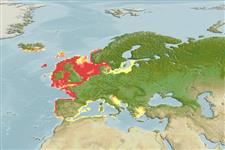>
Gadiformes (Cods) >
Gaidropsaridae (Rocklings)
Etymology: Gaidropsarus: Greek, ga, ge = the earth + Greek, ydro = water + Greek psaros = speckled, starling (Ref. 45335).
Environment: milieu / climate zone / depth range / distribution range
Écologie
marin démersal; non migrateur; profondeur 20 - 120 m (Ref. 35388). Temperate; 64°N - 34°N, 23°W - 27°E
Northeast Atlantic: central Norwegian coast and the Faeroe Islands southwards through the North Sea and around the British Isles to the region around the Straits of Gibraltar. Reported from Iceland (Ref. 12462). Also in the western and northern coasts of the Mediterranean.
Taille / Poids / Âge
Maturity: Lm ? range ? - ? cm
Max length : 60.0 cm TL mâle / non sexé; (Ref. 1371); common length : 25.0 cm TL mâle / non sexé; (Ref. 3397)
Épines dorsales (Total): 0; Épines anales 0. First dorsal ray followed by a row of small, fleshy filaments. Color is varies from dusky to pale. Fin coloration varies geographically in the Western Atlantic, with southern specimens having more dark blotches than northern ones (Ref. 1371). One barbel on the lower jaw and two on the snout. Large chocolate brown spots on head and body (Ref. 35388).
Found on rocky bottoms but also on mud, sand and gravel. Feed on shrimps, crabs, isopods, small fish, mollusks and polychaetes (Ref. 1371). Spawn during spring and summer in the Mediterranean. Eggs and larvae are pelagic (Ref. 1371).
Life cycle and mating behavior
Maturité | Reproduction | Frai | Œufs | Fécondité | Larves
Cohen, D.M., T. Inada, T. Iwamoto and N. Scialabba, 1990. FAO species catalogue. Vol. 10. Gadiform fishes of the world (Order Gadiformes). An annotated and illustrated catalogue of cods, hakes, grenadiers and other gadiform fishes known to date. FAO Fish. Synop. 125(10). Rome: FAO. 442 p. (Ref. 1371)
Statut dans la liste rouge de l'IUCN (Ref. 130435)
Menace pour l'homme
Harmless
Utilisations par l'homme
Pêcheries: intérêt commercial mineur
Plus d'informations
RéférencesAquacultureProfil d'aquacultureSouchesGénétiqueElectrophoresesHéritabilitéPathologiesTraitementNutrientsMass conversion
Outils
Articles particuliers
Télécharger en XML
Sources Internet
Estimates based on models
Preferred temperature (Ref.
123201): 7.1 - 12.6, mean 9.6 °C (based on 254 cells).
Phylogenetic diversity index (Ref.
82804): PD
50 = 0.5001 [Uniqueness, from 0.5 = low to 2.0 = high].
Bayesian length-weight: a=0.00490 (0.00304 - 0.00790), b=3.01 (2.87 - 3.15), in cm total length, based on LWR estimates for this species & (Sub)family-body (Ref.
93245).
Niveau trophique (Ref.
69278): 3.5 ±0.4 se; based on diet studies.
Résilience (Ref.
120179): Milieu, temps minimum de doublement de population : 1,4 à 4,4 années (tmax=6).
Fishing Vulnerability (Ref.
59153): Moderate vulnerability (44 of 100).
Nutrients (Ref.
124155): Calcium = 42.4 [19.9, 94.9] mg/100g; Iron = 0.375 [0.191, 0.788] mg/100g; Protein = 17.5 [15.7, 19.4] %; Omega3 = 0.356 [0.177, 0.686] g/100g; Selenium = 17.9 [9.2, 38.7] μg/100g; VitaminA = 7.64 [1.68, 31.14] μg/100g; Zinc = 0.497 [0.341, 0.757] mg/100g (wet weight);
